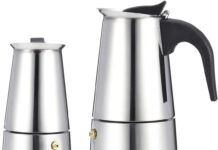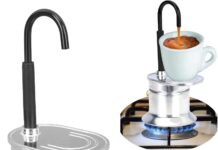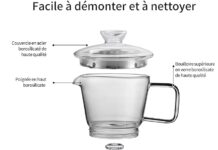Have you ever wondered if your trusty coffee maker can be used to make a cup of tea? Well, the answer may surprise you! In this article, we explore the possibility of using coffee makers to brew tea, examining the pros and cons of this unconventional method. So grab a cup of your favorite beverage and join us on this delightful adventure as we uncover the secrets of tea-making with coffee makers!
Understanding Coffee Makers
How coffee makers work
Coffee makers are a staple in many kitchens and workplaces, and their popularity stems from their simplicity and efficiency in brewing coffee. These machines work by combining water and coffee grounds, allowing the hot water to evenly extract the flavor from the grounds and produce a delicious cup of coffee. Coffee makers typically have a water reservoir, a heating element, and a filter basket where the coffee grounds are placed. The water is heated up and then drips over the coffee grounds, passing through the filter and extracting the flavor as it flows into the carafe.
Types of coffee makers
There are various types of coffee makers available in the market, each offering different features and brewing methods. Some of the most popular types include drip coffee makers, espresso machines, single-serve coffee makers, and French presses.
Drip coffee makers, as the name suggests, work by slowly dripping hot water over the coffee grounds, resulting in a flavorful and aromatic brew. Espresso machines, on the other hand, use high pressure to force hot water through finely ground coffee, creating a concentrated and bold espresso shot. Single-serve coffee makers, such as pod-based machines, offer convenience and versatility by quickly brewing a single cup of coffee using pre-packaged coffee pods. Lastly, French presses use a plunger mechanism to steep coarsely ground coffee in hot water, resulting in a rich and full-bodied brew.
Making Tea with a Coffee Maker
Can coffee makers be used to make tea?
While coffee makers are primarily designed for brewing coffee, they can also be used to make tea. The process of making tea in a coffee maker is relatively similar to brewing coffee, as both involve the infusion of hot water with flavorful substances. However, some considerations must be kept in mind when using a coffee maker for tea to ensure the desired taste and aroma are achieved.
Benefits of using a coffee maker for tea
Using a coffee maker to prepare tea offers several benefits. Firstly, coffee makers provide a convenient and efficient way to heat water quickly, which is essential for steeping tea. The water temperature is also controllable in most coffee makers, allowing tea enthusiasts to adjust it to the optimal temperature for their preferred tea type. Additionally, coffee makers with multiple settings, such as brew strength options, allow individuals to further customize their tea brewing experience.
Drawbacks of using a coffee maker for tea
While coffee makers can be used for making tea, there are a few drawbacks to consider. Firstly, the residual coffee flavors and oils present in the machine’s components may impart a slight coffee taste to the brewed tea, which can impact the purity of the tea’s flavor. Additionally, certain teas require specific steeping times and temperatures that may not align with the capabilities of a coffee maker. Lastly, using a coffee maker for tea may leave behind tea residue that can be difficult to remove, especially if the machine is not designed for dual use.
Tips for Making Tea in a Coffee Maker
Choosing the right coffee maker
When using a coffee maker for tea, it is crucial to choose the right type of machine. Drip coffee makers with removable and washable filters are generally preferred, as they allow for easy cleanup and minimize the chances of residual flavors transferring between coffee and tea. It is also advisable to select a coffee maker with temperature control options, ensuring that the water can reach the ideal temperature for steeping tea.
Selecting the right tea leaves
Using high-quality tea leaves is essential for a flavorful cup of tea. Opt for loose leaf tea rather than tea bags, as this allows the leaves to expand and infuse more effectively. Moreover, choose the type of tea that suits your preference, whether it be black, green, herbal, or any other variety. Pay attention to the brewing instructions provided with the tea, as different teas may require specific steeping times and water temperatures.
Preparing the coffee maker for tea
Before brewing tea in a coffee maker, it is crucial to clean the machine thoroughly to remove any residual coffee flavors or oils. This can be done by running a cycle with vinegar or a specialized coffee maker cleaning solution. Make sure to rinse the machine thoroughly afterward to remove any cleaning solution residue. This step helps ensure that the brewed tea will have a clean and pure taste.
Brewing time and temperature
Tea requires different steeping times and water temperatures depending on the variety being brewed. It is important to refer to the specific instructions provided with the tea to achieve the best results. While most coffee makers have temperature control options, it is still recommended to monitor the water temperature closely to prevent over or under-extraction of the tea’s flavor. Adjust the brewing time accordingly to achieve the desired strength of the tea.
Cleaning and maintenance
Regular cleaning and maintenance of the coffee maker is essential to prevent any cross-contamination between coffee and tea flavors. After brewing tea, it is advisable to thoroughly rinse the machine and remove any residual tea leaves. Wipe any remaining tea residue from the carafe, filter, and other components to keep them clean and ready for future use. Additionally, descaling the coffee maker periodically will help remove any mineral buildup and ensure optimal performance.
Alternative Methods for Making Tea
Using a traditional tea kettle
A traditional tea kettle offers a straightforward and reliable method for making tea. Simply heat water in the kettle until it reaches the desired temperature, then pour it over the tea leaves in a teapot or tea infuser. Allow the tea to steep for the recommended time, and then pour it into cups for serving. This method gives full control over the water temperature and steeping time, ensuring a perfect cup of tea every time.
Using a microwave
In a pinch, a microwave can be used to heat water for making tea. Fill a microwave-safe container with water and place it in the microwave. Heat the water in short increments, checking the temperature regularly with a thermometer. Once the water reaches the desired temperature, it can be poured over the tea leaves and allowed to steep. However, it is important to note that microwaves may heat water unevenly, so extra care must be taken to ensure the water is heated to the correct temperature.
Using a stovetop espresso maker
A stovetop espresso maker, also known as a Moka pot, can be used to brew tea by modifying the brewing process slightly. Instead of placing coffee grounds in the upper chamber, replace them with loose leaf tea. Fill the bottom chamber with water, and as the water heats up, it will create pressure that forces it through the tea leaves, infusing the flavors into the water. This method offers a unique and robust brewing experience that tea enthusiasts may find enjoyable.
Conclusion
While coffee makers are primarily designed for brewing coffee, they can certainly be used to make tea as well. By following the tips outlined above, such as choosing the right coffee maker, selecting high-quality tea leaves, and properly preparing and cleaning the machine, tea lovers can enjoy a flavorful and convenient cup of tea. However, alternative methods, such as using a traditional tea kettle or a stovetop espresso maker, may offer a more precise and tailored tea brewing experience. Ultimately, the choice between using a coffee maker or exploring these alternative methods depends on personal preference and the desired level of control over the tea brewing process. So go ahead, experiment, and discover the perfect cup of tea that suits your taste buds.





































